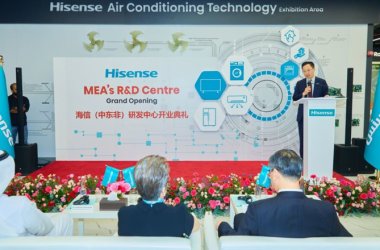Fayez Eweidat, Senior Sales Director – Middle East, Turkey & Africa at Juniper Networks writes an exclusive opinion piece for Tahawultech where he spotlight’s the company holistic approach to sustainability and how automation is the key to staying sustainable.

Climate change is a topic that no one, including IT teams, can afford to ignore these days. The large-scale digital transformation we have seen in recent years has led to more intensive use of network infrastructure and a greater emphasis on network sustainability. A recent report by PWC suggests that companies are driven by climate risk awareness to adopt or have adopted ESG strategies, further indicating the growing importance of sustainability and accountability across industries.
Juniper Networks partnered with Vanson Bourne to conduct a survey of 650 IT decision makers (ITDMs) and 1,200 office workers across EMEA to gauge confidence in sustainable networking transformation within business. Juniper’s “Future of Networking” report found that, 54 percent of respondents from Saudi Arabia and 62 percent of those in the UAE thought that sustainable networking is extremely important in terms of making a significant contribution towards ongoing climate change measures. However, 46 percent of respondents from Saudi Arabia and 37 percent of respondents from the UAE also stated that their organization’s leadership only have a fair understanding of the impact of the technology choices in the context of sustainability.
To close this knowledge gap, it is essential that IT leaders learn about the various aspects that contribute to a sustainable network. After all, a sustainable network entails more than solemnly reducing the energy consumption of the network or the use of “green packaging.” What steps can IT managers take to make their network more sustainable and reduce their impact on the environment?
Broad view of sustainability
From top to bottom, organizations need to have a broad understanding of sustainability. It is important to look beyond just what savings network infrastructure can bring. There are many factors that can reduce the total environmental impact of a network infrastructure apart from reduced energy consumption, such as the supply chains and equipment vendors, the product life cycle, and total waste. Businesses should ensure that their network supplier works together with their supply chain partners to ensure responsible, fair, and sustainable business throughout the entire supply chain. When looking at waste reduction, organizations should take into account the waste that relates to effectively utilizing the energy that is consumed, the time to troubleshoot inefficiencies, hardware waste at the end of life stage and, for example, unused bandwidth.
By looking beyond the energy savings that a network can bring and creating a network that, for example, reduces commuting time, automatically minimizes energy waste, has a greener supply chain, and requires less maintenance and technician presence, the overall environmental impact will be reduced. A broad view of sustainability is essential to building a greener and more efficient network.
Automation is key
Lowering the emissions that stem from usage through energy optimization with AI-enabled automation can, therefore, make an incredible impact. Network automation through artificial intelligence (AI) and machine learning (ML) is the process of automating the planning, implementation, operations, and optimization of network structures. This allows manual tasks and processes at any stage of the network lifecycle to be taken over by software applications that can complete them repeatably and reliably. In addition, this software can provide predictive analytics, make recommendations to network operations teams, and act independently, allowing network problems to be fixed automatically. The possibility of human error is reduced, and engineers need to do less repetitive work. All of this contributes to an overall greener infrastructure where less energy is consumed in fixing errors.
Moreover, network automation reduces work-related travel because networks can be deployed faster and only a single site visit is required, which reduces travel related emissions. Industry research has shown that IT-teams managing network infrastructures often spend more than 40 percent of their time troubleshooting issues. This time can be significantly reduced when networks are automated. Network engineers will therefore spend less time commuting to sites and fixing issues and can work from one fixed location or even from home more often.
In addition to saving through efficiency, automation also leads to smart, direct energy savings through automated energy management. An example of such is having access points automatically shut down at the end of the workday. This ensures that power consumption is minimized when few or no people are at the office. When someone logs back into one of the access points, it will automatically turn back on.
The corporate network in the home environment
Working from home is still the new normal and is expected to remain so. Working from home not only has advantages for employees themselves, but also reduces CO2 emissions significantly. Research by CE Delft shows that several billion kilometers of commuting can quickly be saved if employees work from home one and a half days more than before. This yields an estimated climate gain of no less than 353,600 tons of CO2. However, a good home office cannot exist without a good internet connection.
By extending the company network to the home environment, companies ensure that employees have an outstanding connection when working from home, which effectively reduces commuting and thus contributes to reducing overall CO2 emissions. Also, a good home network boosts the productivity of employees working from their living room. A win-win situation.
Proactive rather than reactive management
A proactive management approach is a key requirement for a sustainable, functioning network. Automation through AI is a key player in this. Proactive management will lead to fewer IT tickets, increased user satisfaction, and thus a reduction in the number of engineers and technicians having to troubleshoot on-site. For example, one major retailer experienced an 85 percent reduction in site visits for troubleshooting thanks to the deployment of AI technologies.
Looking beyond the standard parameters of sustainability, such as power consumption, opens up a plethora of opportunities to make the network more sustainable. As a result, organizations will not only operate greener, but will also become more efficient and user-friendly.





